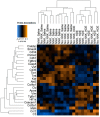Aspirin-Triggered Resolvin D1 Reduces Chronic Dust-Induced Lung Pathology without Altering Susceptibility to Dust-Enhanced Carcinogenesis
- PMID: 35454807
- PMCID: PMC9032113
- DOI: 10.3390/cancers14081900
Aspirin-Triggered Resolvin D1 Reduces Chronic Dust-Induced Lung Pathology without Altering Susceptibility to Dust-Enhanced Carcinogenesis
Abstract
Lung cancer is the leading cause of cancer-related deaths worldwide, with increased risk being associated with unresolved or chronic inflammation. Agricultural and livestock workers endure significant exposure to agricultural dusts on a routine basis; however, the chronic inflammatory and carcinogenic effects of these dust exposure is unclear. We have developed a chronic dust exposure model of lung carcinogenesis in which mice were intranasally challenged three times a week for 24 weeks, using an aqueous dust extract (HDE) made from dust collected in swine confinement facilities. We also treated mice with the omega-3-fatty acid lipid mediator, aspirin-triggered resolvin D1 (AT-RvD1) to provide a novel therapeutic strategy for mitigating the inflammatory and carcinogenic effects of HDE. Exposure to HDE resulted in significant immune cell influx into the lungs, enhanced lung tumorigenesis, severe tissue pathogenesis, and a pro-inflammatory and carcinogenic gene signature, relative to saline-exposed mice. AT-RvD1 treatment mitigated the dust-induced inflammatory response but did not protect against HDE + NNK-enhanced tumorigenesis. Our data suggest that chronic HDE exposure induces a significant inflammatory and pro-carcinogenic response, whereas treatment with AT-RvD1 dampens the inflammatory responses, providing a strong argument for the therapeutic use of AT-RvD1 to mitigate chronic inflammation.
Keywords: epithelial to mesenchymal transition (EMT); fibrosis; lung cancer; lung inflammation; omega-3 fatty acids; organic dust; specialized pro-resolving mediators (SPM); therapeutic.
Conflict of interest statement
The authors declare no conflict of interest.
Figures












Similar articles
-
A High Docosahexaenoic Acid Diet Alters the Lung Inflammatory Response to Acute Dust Exposure.Nutrients. 2020 Aug 4;12(8):2334. doi: 10.3390/nu12082334. Nutrients. 2020. PMID: 32759853 Free PMC article.
-
A high docosahexaenoic acid diet alters lung inflammation and recovery following repetitive exposure to aqueous organic dust extracts.J Nutr Biochem. 2021 Nov;97:108797. doi: 10.1016/j.jnutbio.2021.108797. Epub 2021 Jun 12. J Nutr Biochem. 2021. PMID: 34126202 Free PMC article.
-
Alcohol exposure alters mouse lung inflammation in response to inhaled dust.Nutrients. 2012 Jul;4(7):695-710. doi: 10.3390/nu4070695. Epub 2012 Jul 4. Nutrients. 2012. PMID: 22852058 Free PMC article.
-
Insufficient zinc intake enhances lung inflammation in response to agricultural organic dust exposure.J Nutr Biochem. 2019 Aug;70:56-64. doi: 10.1016/j.jnutbio.2019.04.007. Epub 2019 May 3. J Nutr Biochem. 2019. PMID: 31153019 Free PMC article.
-
Resolvin D1: A key endogenous inhibitor of neuroinflammation.Biofactors. 2022 Sep;48(5):1005-1026. doi: 10.1002/biof.1891. Epub 2022 Sep 29. Biofactors. 2022. PMID: 36176016 Review.
Cited by
-
Fibrotic and emphysematous murine lung mechanics under negative-pressure ventilation.Am J Physiol Lung Cell Mol Physiol. 2025 Mar 1;328(3):L443-L455. doi: 10.1152/ajplung.00087.2024. Epub 2025 Jan 15. Am J Physiol Lung Cell Mol Physiol. 2025. PMID: 39812236 Free PMC article.
-
Specialized pro-resolving mediators in vascular inflammation and atherosclerotic cardiovascular disease.Nat Rev Cardiol. 2024 Nov;21(11):808-823. doi: 10.1038/s41569-023-00984-x. Epub 2024 Jan 12. Nat Rev Cardiol. 2024. PMID: 38216693 Review.
-
SiO2 nanoparticles as disruptors of endogenous resolution mechanisms of inflammatory responses that exacerbate pneumonia.Sci Rep. 2025 Feb 21;15(1):6398. doi: 10.1038/s41598-025-89700-y. Sci Rep. 2025. PMID: 39984537 Free PMC article.
-
Aspirin-Triggered Resolvin D1 (AT-RvD1) Protects Mouse Skin against UVB-Induced Inflammation and Oxidative Stress.Molecules. 2023 Mar 6;28(5):2417. doi: 10.3390/molecules28052417. Molecules. 2023. PMID: 36903662 Free PMC article.
-
Aspirin-triggered resolvin D1 modulates pulmonary and neurological inflammation in an IL-22 knock-out organic dust exposure mouse model.Front Immunol. 2024 Dec 17;15:1495581. doi: 10.3389/fimmu.2024.1495581. eCollection 2024. Front Immunol. 2024. PMID: 39776904 Free PMC article.
References
-
- Romberger D.J., Heires A.J., Nordgren T.M., Souder C.P., West W., Liu X.-d., Poole J.A., Toews M.L., Wyatt T.A. Proteases in agricultural dust induce lung inflammation through PAR-1 and PAR-2 activation. Am. J. Physiol. Lung Cell. Mol. Physiol. 2015;309:L388–L399. doi: 10.1152/ajplung.00025.2015. - DOI - PMC - PubMed
Grants and funding
LinkOut - more resources
Full Text Sources
Molecular Biology Databases

